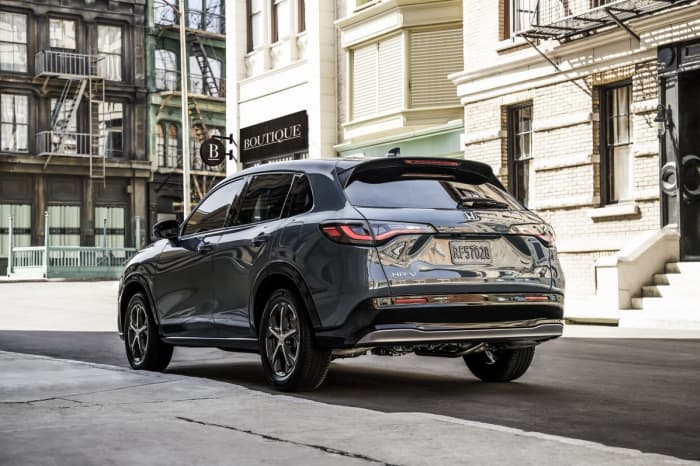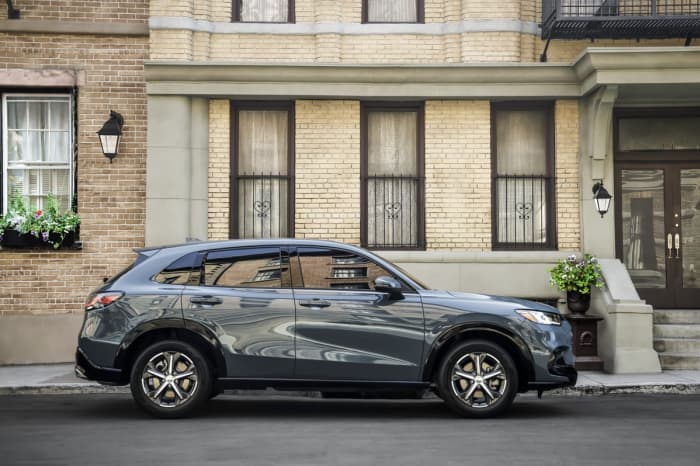This post was originally published on this site
Pros
- Spacious cabin
- Honda quality
- Lots of safety features
Cons
- No hybrid variant
- Magic Seat has disappeared
What’s new?
- This is an all-new generation
- Now based on the Civic
- More power than before
The 2023 Honda HR-V marks a new generation of this subcompact SUV, and it’s shaping up to continue the impressive ways of its predecessor. Prices start at $23,650.
One of the best subcompact SUVs is updated. The 2023 Honda HR-V becomes even more compelling and refined. Honda
HMC,
builds this second-generation model on the same platform as the current Civic, which only launched last year (the original HR-V was based on the little Fit hatchback).
That means a more sophisticated suspension for better ride quality, plus a keener engine. The new HR-V is also completely contemporary inside and out. Safety tech starts quite generously, but spending a little more for blind-spot monitoring and a few extra features is a good idea.
The previous Honda HR-V never got accused of being too powerful. The new 2023 HR-V comes with 158 horsepower and 138 lb-ft of torque — a noticeable improvement over 141 horsepower and 127 lb-ft of thrust. While there’s a slight decrease in fuel efficiency compared with the former model, this new HR-V averages 28 mpg combined with front-wheel drive, so it’s a bearable trade-off for the added power.
Read: 10 top hybrids for less than $30,000
Active noise cancellation is standard, and the previous torsion beam rear suspension has been replaced by a multi-link setup offering greater comfort and control. All-wheel drive is available, and hill descent control is standard in every new HR-V. Just like its predecessor, though, this subcompact SUV doesn’t have any serious off-road talent. Those who live in colder regions will nevertheless appreciate the value of having four driven wheels

The 2023 Honda HR-V. Pictured is the EX-L.
Honda
2023 Honda HR-V pricing
The new Honda HR-V subcompact SUV starts with a manufacturer’s suggested retail price of $23,650 for the front-drive LX model, plus a destination charge.
Sport trim is almost $25,650, and the top EX-L version comes in close to $27.5K. Adding all-wheel drive to any trim is another $1,500; premium paint costs $395.
For comparison, the Mazda
MZDAY,
CX-30 and Subaru
FUJHF,
Crosstrek (both with all-wheel drive as standard) begin in the $24K region. The Toyota
TM,
C-HR, Kia
000270,
Seltos, and Hyundai
HYMTF,
Kona all start in the low $20K range.
Before buying a new HR-V SUV, check the KBB.com Fair Purchase Price to see what others in your area paid for theirs. The previous generation of HR-V retained its value well. This second-generation should do the same.
Driving the 2023 Honda HR-V
KBB’s Micah Muzio drove a new HR-V recently in Oregon. Reports Micah:
The HR-V drives with more sophistication than its price would suggest, lending itself to pleasing commutes. But is there any fun to be extracted along the way? Yes. The HR-V corners with confidence, and there’s just a splash of sportiness, aided by steering that has a satisfying heft and predictability.
At full-throttle, the HR-V feels peppy. And truth be told, the continuously variable automatic transmission (CVT) works great. While CVTs routinely are criticized for creating an elastic acceleration curve accompanied by a racing engine, Honda’s CVT feels a lot like a conventional automatic. Most folks will have no idea it’s a CVT.
Other random observations: The outward view from the HR-V’s driver’s seat is good, cabin noise at highway speeds is more than tolerable, and unfortunately there are no vents for the rear seat. And while I miss the former HR-V’s cleverly folding Magic Seat, I do like how the new small keyfob minimizes bulk in your pockets. What’s more, the HR-V’s lane-keeping assist feature does an exceptional job keeping the HR-V in its lane, but I found the adaptive cruise control to be a bit slow in adapting to the changing speed of the vehicle ahead.
All told, the new HR-V feels more substantive than the vehicle it replaces, and I like how each trim has a flavor of its own. In fact, the elevated aura of the new 2023 Honda HR-V relates directly to its improved interiors.
Also see: The 25 bestselling SUVs

2023 Honda HR-V
Uncredited
Interior comfort
The magic has gone — in a certain sense. The previous HR-V had a Magic Seat behind the first row where the bottom cushions could flip up and contribute to cargo-carrying versatility. Honda fits a set of typical 60/40 split-folding rear seats into the 2023 HR-V. They can still fold flat to create an extremely useful load space, but who doesn’t want a Magic Seat?
Elsewhere in the new HR-V’s cabin, some magic carries over. There’s the usual Honda fit and finish, and an increasingly common minimalist approach to the dashboard — with controls migrating to the touchscreen and/or the steering wheel.
A more maximalist approach applies to rear legroom: 37.7 inches. That’s one of the best in this subcompact SUV class, although slightly less than the old HR-V. Luggage space behind the rear seats measures 24.4 cubic feet. Maximum cargo area with the rear seats folded is 55.1 cubic feet. The Kia Seltos has more, but the HR-V is another class standout.
Exterior styling
New generation, new look. The 2023 HR-V loses the designed-by-committee vibe and puts forward a more distinct appearance.
Because of its Civic foundation, the new HR-V not-so-subcompact SUV is bigger than before. Its wheelbase (the distance between the front and rear axles) expands by nearly 2 inches. Width grows by about 2.5 inches. And overall length is greater by almost 9.5 inches.
The alloy wheels of the LX are painted silver, the Sport’s rims are gloss black (matched by a grille, side mirror housings, and rear spoiler also in gloss black), and the EX-L’s alloys are machine-finished with inserts of Gloss Shark Gray. Premium paint choices are Nordic Forest Pearl, Platinum White Pearl, and Urban Gray Pearl.
Favorite features
HondaLink
Download the HondaLink app onto a smartphone, and a range of services becomes available, such as stolen vehicle location, geofencing, automatic collision notification, and service appointments. This is standard with every new HR-V SUV.
Smart entry with walkaway auto lock
“Did I lock the car?” This question invariably springs to mind just as your plane takes off and you see all the long-term parking lots becoming smaller. With this feature, standard in the top two trims, such angst becomes a thing of the past.
Standard features
The introductory LX trim of the new HR-V subcompact SUV is not exactly overflowing with standard features, but it does have a decent amount of driver aids — forward collision warning with automatic emergency braking, lane-departure warning/lane-keeping assistance, adaptive cruise control with low-speed follow, Traffic Jam Assist, and automatic high beams.
The rest of the inventory includes 17-inch alloy wheels, LED headlights/daytime running lights/brake lights, single-zone automatic climate control, and cloth upholstery. The infotainment system has a 7-inch touchscreen, Apple
AAPL,
CarPlay/Android Auto smartphone integration, three USB ports, Bluetooth, and four speakers.
Don’t miss: Car quality is slipping: These are the brands with the most and least complaints, study finds
Factory options
Except for all-wheel drive, the way to acquire more equipment in a 2023 HR-V is to select a higher trim, rather than cherry pick from a list of options. Sport trim is a couple of grand more than LX, adding 18-inch alloy wheels, blind-spot monitoring with rear cross-traffic alert, keyless entry/ignition with Walk Away Auto Lock, leather-wrapped steering wheel, and heated front seats.
EX-L reverts to 17-inch alloy wheels and brings low-speed braking control, powered moonroof, front/rear parking sensors, dual-zone automatic climate control, 8-way power-adjustable driver’s seat, leather seating surfaces, self-dimming rearview mirror, ambient LED cabin lighting, turn-by-turn directions, 9-inch touchscreen, wireless Apple CarPlay/Android Auto, wireless charging, satellite radio, and an 8-speaker/180-watt audio system.
Check out: 12 best American road trips
Engine and transmission
One engine covers all three new HR-V trim levels. It’s a 2.0-liter 4-cylinder unit without any turbocharging.
Output is 158 horsepower and 138 lb-ft of torque. This connects to an automatic continuously variable transmission (CVT). Front-wheel drive (FWD) is standard. All-wheel drive (AWD) is optional across the lineup. Regular gasoline is perfectly acceptable.
2.0-liter inline-4
158 horsepower @ 6,500 rpm
138 lb-ft of torque @ 4,200 rpm
EPA city/highway fuel economy: 26/32 mpg (FWD), 25/30 mpg (AWD)
This story originally ran on KBB.com.


